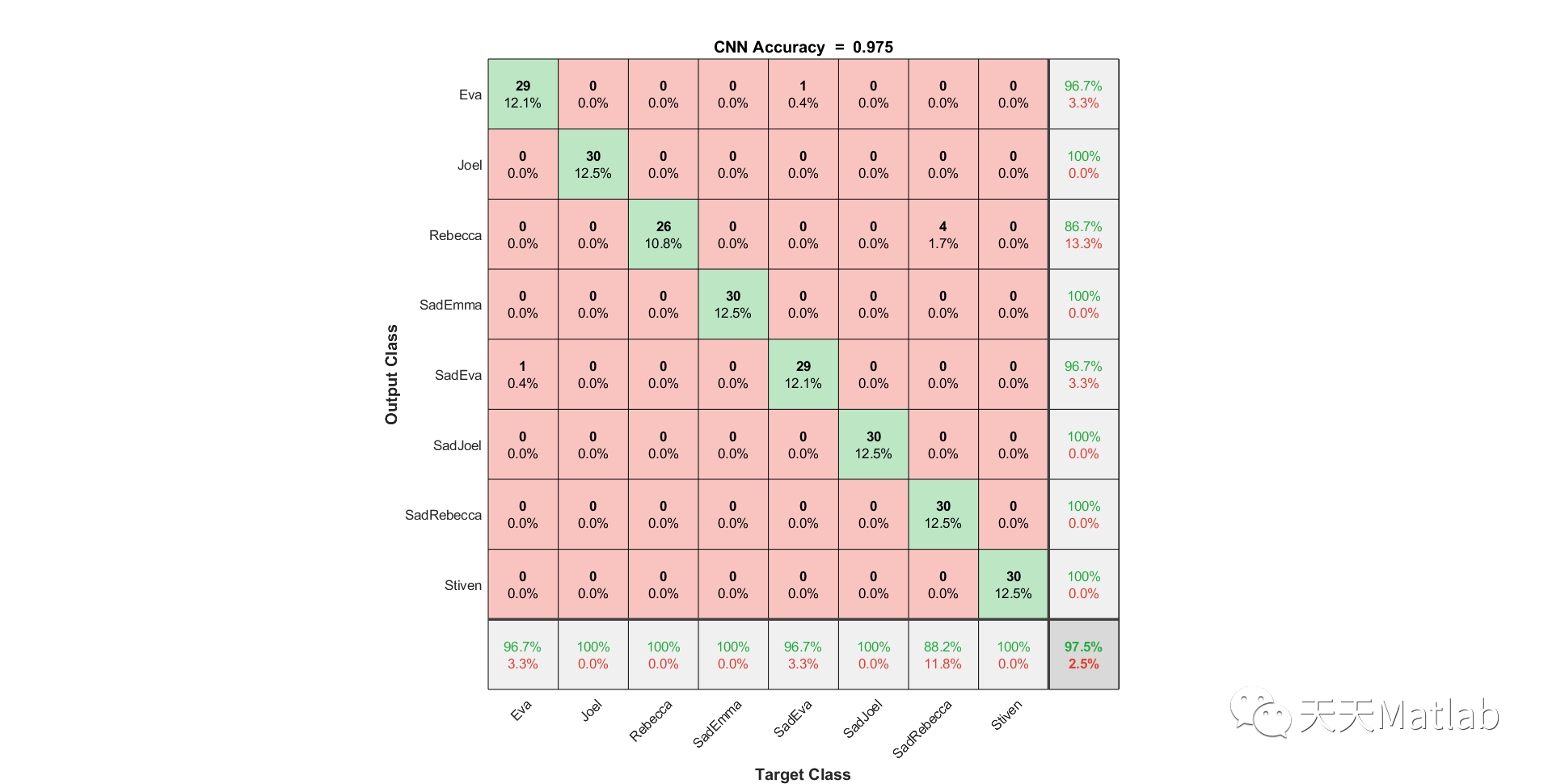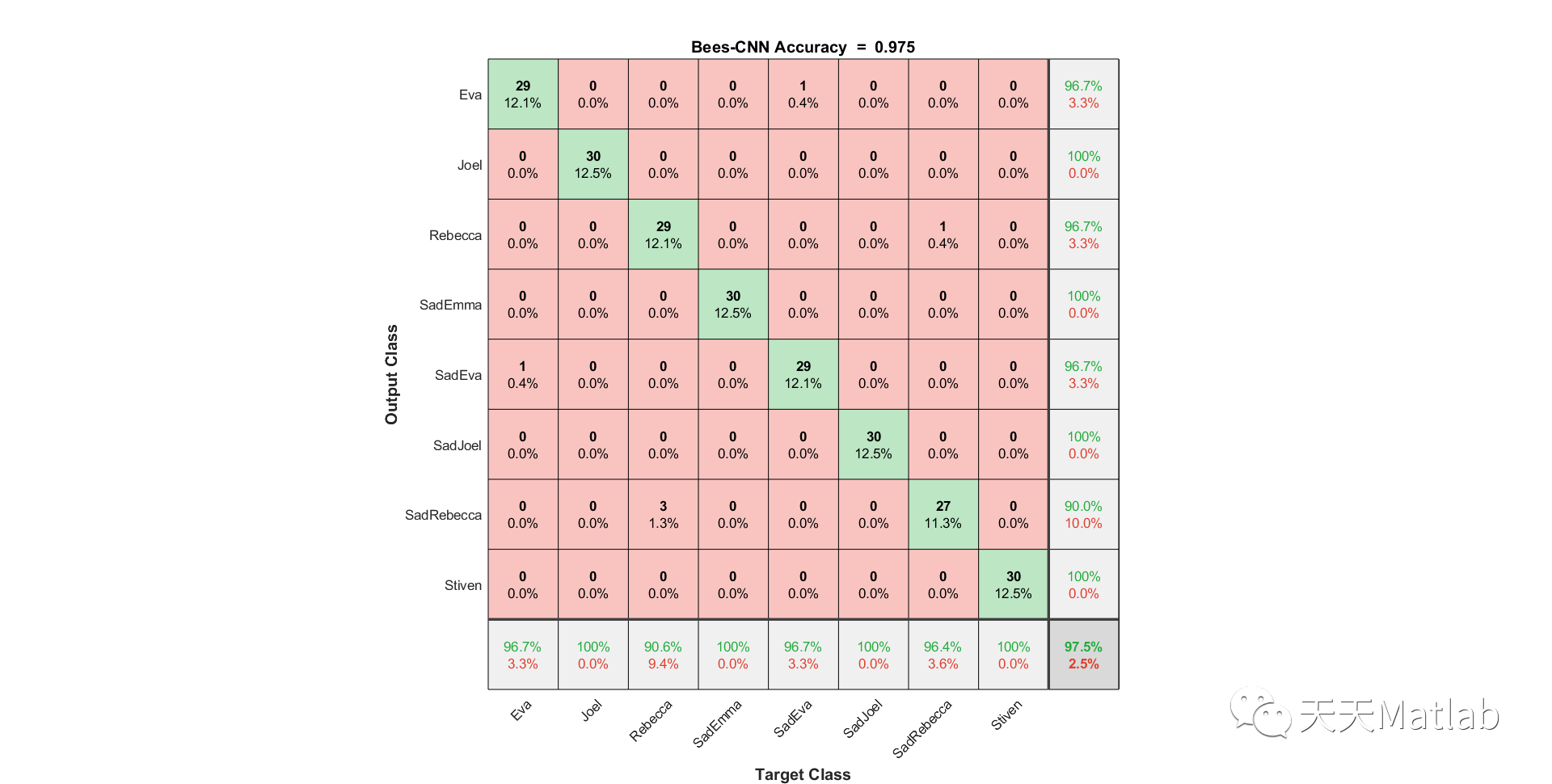1 简介
?随着经济的发展和社会的高速进步,图像数据在我们日常生活中发挥着越来越重要的作用.图像数据的爆炸式增长使得需要分类的事物种类越来越多,而且被分类的对象内容也越来越复杂.传统的图像分类方法已经不能满足现实应用的需要,如何在大数据下提高图像分类的准确率意义重大.卷积神经网络(Convolutional Neural Network,CNN)是一个新型的人工神经网络方法,在处理二维图像领域表现出良好的性能,因此卷积神经网络被广泛地应用在图像分类领域.图像分类的正确率受卷积神经网络结构的影响,因此研究卷积神经网络结构优化问题具有重要的理论价值和实用价值.本文提出一种基于蜜蜂优化算法优化卷积神经网络参数从而达到改进图像分类效果?的目的。
2 部分代码
%% Bees CNN Algorithm (A Fuzzy Evolutionary Deep Leaning) - Created in 20 Jan 2022 by Seyed Muhammad Hossein Mousavi
% It is possible to fit deep learning weights and bias using evolutionary
% algorithm, right after training stage. Here, CNN is used to classify 8
% face classes. After CNN train, initial fuzzy model is created to aid the
% learning process. Finally, CNN network weights (from Fully Connected Layer)
% trains using Bees algorithm
% to be fitted in a nature inspired manner (here behavior of Bees). You can
% used your data with any number of samples and classes. Remember, code's
% parameters are adjusted for this data and if you want to replace your
% data you may have to change the parameters. Image data is in 64*64 size and
% in 2 dimensions and stored in 'CNNDat' folder. So, important parameters
% are as below:
% 1.
% 'numTrainFiles' = you have to change this based on number of your samples
% in each class. for example if each class has 120 sample, 90 is good
% enough as 90 samples considered for train and others for test.
% 2.
% 'imageInputLayer' = it is size of your image data like [64 64 1]
% 3.
% 'fullyConnectedLayer' = it is number of your classes like (8)
% 4.
% 'MaxEpochs' = the more the better and more computation run time like 40
% 5.
% 'ClusNum' = Fuzzy C Means (FCM) Cluster Number like 3 or 4 is nice
% 6.
% These two are from "BEEFCN.m" function :
% 'Params.MaxIt' = it is iteration number in Bees algorithm. 20 is good
% 'Params.nScoutBee' = it is population number in Bees algorithm. Like 10.
%% Cleaning
clear;
clc;
close all
warning('off');
%% CNN Deep Neural Network
% Load the deep sample data as an image datastore.
deepDatasetPath = fullfile('CNNDat');
imds = imageDatastore(deepDatasetPath, ...
'IncludeSubfolders',true, ...
'LabelSource','foldernames');
% Divide the data into training and validation data sets
numTrainFiles = 90;
[imdsTrain,imdsValidation] = splitEachLabel(imds,numTrainFiles,'randomize');
% Define the convolutional neural network architecture.
layers = [
% Image Input Layer An imageInputLayer
imageInputLayer([64 64 1])
% Convolutional Layer
convolution2dLayer(3,8,'Padding','same')
% Batch Normalization
batchNormalizationLayer
% ReLU Layer The batch
reluLayer
% Max Pooling Layer
% More values means less weights
maxPooling2dLayer(4,'Stride',4)
%------------------------------
convolution2dLayer(3,8,'Padding','same')
batchNormalizationLayer
reluLayer
maxPooling2dLayer(5,'Stride',5)
convolution2dLayer(3,8,'Padding','same')
batchNormalizationLayer
reluLayer
% Fully Connected Layer (Number of Classes)
fullyConnectedLayer(8)
% Softmax Layer
softmaxLayer
% Classification Layer The final layer
classificationLayer];
% Specify the training options
options = trainingOptions('sgdm', ...
'InitialLearnRate',0.001, ...
'MaxEpochs',20, ...
'Shuffle','every-epoch', ...
'ValidationData',imdsValidation, ...
'ValidationFrequency',8, ...
'Verbose',false, ...
'Plots','training-progress');
% Train the network
[net,info]= trainNetwork(imdsTrain,layers,options);
%% Bees Algorithm Weight Fitting
% Converting Serial Network to an Object
netobj = net.saveobj;
% Extracting Fully Connected Layer's Weights To Evolve
FullConn=netobj.Layers(13, 1).Weights;
netbias=netobj.Layers(13, 1).Bias;
%% Data for Each Weight
sizefinal=size(FullConn);
sizefinal=sizefinal(1,1);
for i=1:sizefinal
Inputs=FullConn(i,:);
Targets=Inputs;
data.Inputs=Inputs;
data.Targets=Targets;
datam{i}=JustLoad(data);
end;
%% Making Basic Fuzzy Model for Each Class Weight
% Fuzzy C Means (FCM) Cluster Number
ClusNum=3;
% Creating Initial Fuzzy Model to Employ for Each Class Weight
for i=1:sizefinal
fism{i}=GenerateFuzzy(datam{i},ClusNum);
end
%% Tarining Bees Algorithm
% Fitting Fully Connected Layer's Weights with Bees Algorithm
for i=1:sizefinal
disp(['Bees Are Working on Weights of Class # (' num2str(i) ')']);
BeesFISm{i}=BEEFCN(fism{i},datam{i});
end;
%% Train Output Extraction
for i=1:sizefinal
TrTar{i}=datam{i}.TrainTargets;
TrInp{i}=datam{i}.TrainInputs;
TrainOutputs{i}=evalfis(TrInp{i},BeesFISm{i});
end;
% Train Errors
for i=1:sizefinal
tmp=datam{i};
tt=tmp.TrainTargets;
tp=TrainOutputs{i};
Errors{i}=tt-tp;
MSE{i}=mean(Errors{i}.^2);
RMSE{i}=sqrt(MSE{i});
error_mean{i}=mean(Errors{i});
error_std{i}=std(Errors{i});
end;
% Convereting Output Cell to Matrix
for i=1:sizefinal
EvolvedFullConn(i,:)=TrainOutputs{i}';
end;
%% Replacing Evolved Weights
netobj.Layers(13, 1).Weights=EvolvedFullConn;
% New Network
Newnet=netobj.Layers;
% Converting Network to Serial Network
BeesNet = assembleNetwork(Newnet);
%% Predict The Labels
% Common CNN Accuracy
YPred = classify(net,imdsValidation);
YValidation = imdsValidation.Labels;
CNNaccuracy = sum(YPred == YValidation)/numel(YValidation);
% Bees CNN Accuracy
YPredbee = classify(BeesNet,imdsValidation);
YValidationbee = imdsValidation.Labels;
Beesaccuracy = sum(YPredbee == YValidationbee)/numel(YValidationbee);
%% Confusion Matrix
figure;
plotconfusion(YPred,YValidation);
title(['CNN Accuracy = ' num2str(CNNaccuracy)]);
figure;
plotconfusion(YPredbee,YValidationbee);
title(['Bees-CNN Accuracy = ' num2str(Beesaccuracy)]);
%% Statistics
fprintf('The CNN Accuracy Is = %0.4f.\n',CNNaccuracy*100)
fprintf('The Bees CNN Accuracy Is = %0.4f.\n',Beesaccuracy*100)
3 仿真结果


4 参考文献
[1]吴正文. 卷积神经网络在图像分类中的应用研究[D]. 电子科技大学.
博主简介:擅长智能优化算法、神经网络预测、信号处理、元胞自动机、图像处理、路径规划、无人机等多种领域的Matlab仿真,相关matlab代码问题可私信交流。
部分理论引用网络文献,若有侵权联系博主删除。